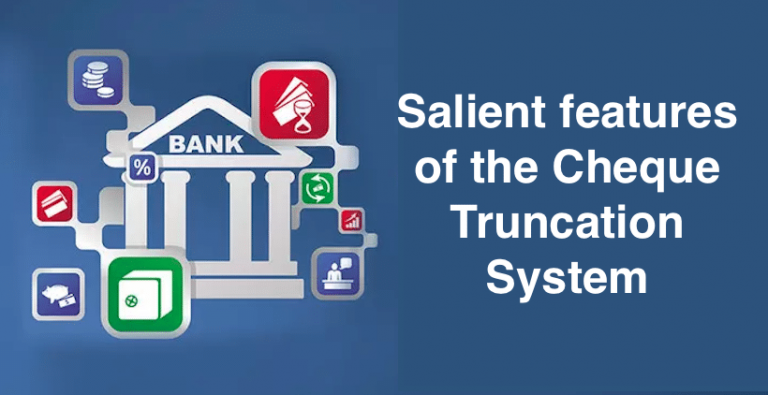Salient features of the Cheque Truncation System: Truncation is the process of stopping the flow of the physical cheque issued by a drawer to the drawee branch. The physical instrument will be truncated at some point en-route to the drawee branch and an electronic image of the cheque would be sent to the drawee branch along with relevant information like the MICR fields, date of presentation, presenting banks etc. thus the physical movement of cheques across branches would not be required, except in exceptional circumstances. This would effectively reduce the time required for payment of cheques, the associated cost of transit and delay in processing, etc., thus speeding up the process of collection.
Salient features of the Cheque Truncation System
The system thus enhances customer service, reduces reconciliation problems, eliminates logistic problems etc. Cheque truncation is also a more secure system than the current exchange of physical documents in which the cheques move from one point to another, thus not only creating delays but inconvenience to the customer in case the instrument is lost in transit or manipulated during the clearing cycle. It is thus an important efficiency enhancement initiative in the payment system area, undertaken by RBI.
The images captured at the presenting bank level would be transmitted to the Clearing House and then to the drawee branches with digital signatures of the presenting bank. Thus each image would carry the digital signature, apart from the physical endorsement of the presenting bank, in a prescribed manner. In order to ensure only images of requisite quality reach the drawee branches, there will be a quality check process at the level of the Capture Systems and Clearing House Interface. In addition, drawers could consider using holograms, bar-coding, or such other features, which would add to the uniqueness of images.
To ensure security, safety and non-repudiation the PKI (Public Key Infrastructure) is being implemented across the system. The banks will send the captured images and data to the central clearing house for onward transmission to the payee/drawee banks. For the purpose RBI will be providing the banks software called the Clearing House Interface (CH I).
The clearing house will process the data and arrive at the settlement figure for the banks and send the required data to payee/drawee banks for processing at their end. It will be the responsibility of the drawee bank Capture System to process the inward data and images and generate the return file for unpaid instruments.
The criteria for banks participating in the cheque truncation system are – (i) Membership of the clearing house in the NCR and (ii) Membership of the Indian Financial Network (INFINET). In respect of banks who are not members of INFINET, they may become the sub-members of the direct members or may use the infrastructure of the other banks having INFINET membership.
Imaging of cheques can be based on various technology options. The cheque images can be black and white, Grey Scale or coloured. Black and White images do not reveal all the subtle features that are there in the cheques. Coloured images increase storage and network bandwidth requirements, so it was decided that the electronic images of truncated cheques will be in grey scale technology.
As all the payments will be made on the basis of images, it is essential to ensure the quality of the images. RBI will be specifying the image standards to the member banks. The presenting bank is required to perform the quality audit during the capture itself. Further quality audit will be done at the gateway before onward transmission to clearing house. The drawee bank can ask for the physical instrument if it is not satisfied about the image quality for payment processing.
All the local cheques can be presented in the CTS. Cheques on banks situated outside the NCR, provided such banks have branches in the NCR region can also be presented. CTS also supports intercity clearing and high value clearing. The on-us instruments (where the presenting and drawee branches are of the same bank) are not allowed.
Customers should use dark coloured ink while writing cheques. The use of rubber stamps should not overshadow the clear appearance of basic features of the cheques (date, payee’s name, amount and drawer’s signature).
Under CTS, after the capture of image, the physical cheque will be warehoused with the presenting bank. In case the beneficiary or any other connected persons require the instrument, the payee bank could issue a copy of image, under its authentication, which is called Image Replacement Document (IRD). NI Act section 81(3) permits the usage of such IRDs.
It would be obligatory for presenting bank to warehouse the physical instruments for the prescribed statutory period. In case a customer desires to get a paper instrument back, the instrument can be sourced from the presenting bank through the drawee bank.
Recommended
